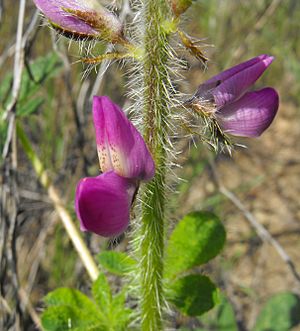Stinging annual lupine facts for kids
Quick facts for kids Stinging annual lupine |
|
|---|---|
 |
|
| Scientific classification | |
| Genus: |
Lupinus
|
| Species: |
hirsutissimus
|
Lupinus hirsutissimus, also known as the stinging annual lupine or stinging lupine, is a type of lupine plant. It grows naturally in the coastal mountains of Baja California and Southern California. You can find it as far north as the San Francisco Bay Area. This plant likes to grow on dry mountain slopes. It often appears in areas that have recently had wildfires, and in chaparral and woodlands habitats.
About the Stinging Lupine
The stinging lupine is an annual herb. This means it completes its whole life cycle in one year. It grows straight up, usually between 20 centimeters (about 8 inches) and one meter (about 3 feet) tall. After a wildfire, it can sometimes grow even taller than one meter.
What It Looks Like
The stem and leaves of this plant are covered in long, stiff hairs. These hairs can sting your skin if you touch them, which is how the plant gets its name!
Each leaf looks like a hand with fingers spread out. This is called a palmate leaf. Each leaf has 5 to 8 smaller parts, called leaflets. These leaflets can be up to 5 centimeters (about 2 inches) long and 1 or 2 centimeters (less than an inch) wide.
Flowers and Seeds
The plant produces several flowers on a stalk, which is called an inflorescence. The flowers are usually dark pink. Each flower is about 1 to 2 centimeters (less than an inch) long. They have a yellowish or pinkish spot on their top petal, which is called the banner.
After the flowers bloom, the plant forms fruits. These fruits are hairy pods, called legume pods, and can grow up to 4 centimeters (about 1.5 inches) long. These pods contain the plant's seeds.
See also
 In Spanish: Lupinus hirsutissimus para niños
In Spanish: Lupinus hirsutissimus para niños

